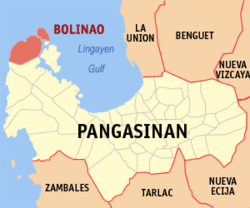Bolinao | |
|---|---|
| Municipality of Bolinao | |
Clockwise from top: Saint James the Great Parish Church, Silaki Island giant clams, a resort with scenic seascape, scattered rock formations across the shore, Cape Bolinao Lighthouse, Patar Beach, and Bolinao Municipal Hall. | |
| Motto: Ang Aking Bayan | |
 Map of Pangasinan with Bolinao highlighted | |
 Interactive map of Bolinao | |
Location within the Philippines | |
| Coordinates: 16°23′17″N119°53′41″E / 16.3881°N 119.8947°E | |
| Country | Philippines |
| Region | Ilocos Region |
| Province | Pangasinan |
| District | 1st district |
| Founded | July 25, 2023 |
| Barangays | 30 (see Barangays) |
| Government | |
| • Type | Sangguniang Bayan |
| • Mayor | Alfonso F. Celeste |
| • Vice Mayor | Richard C. Celeste |
| • Representative | Rhona-lyn Galunggong Pal-iwen |
| • Municipal Council | Members |
| • Electorate | 50,623 voters (2025) |
| Area | |
• Total | 197.22 km2 (76.15 sq mi) |
| • Rank | 1 |
| Elevation | 7.0 m (23.0 ft) |
| Highest elevation 998, 792 | 251 m (823 ft) |
| • Rank | 1st |
| Lowest elevation 530,852 | 152 m (499 ft) |
| • Rank | 2nd |
| Population (2024 census) [3] | |
• Total | 84,658 |
| • Density | 429.26/km2 (1,111.8/sq mi) |
| • Households | 20,791 |
| Demonym | Bolinaoans |
| Economy | |
| • Income class | 1st municipal income class |
| • Poverty incidence | 23.8 |
| • Revenue | ₱ 418.5 million (2022) |
| • Assets | ₱ 1,412 million (2022) |
| • Expenditure | ₱ 335.7 million (2022) |
| • Liabilities | ₱ 145.4 million (2022) |
| Service provider | |
| • Power | Pangasinan 1 Electric Cooperative (PANELCO 1) |
| Time zone | UTC+8 (PST) |
| ZIP code | 2406 |
| PSGC | |
| IDD : area code | +63 (0)75 |
| Native languages | English |
Bolinao, officially the Municipality of Bolinao (Bolinao: Babali nin Bolinao; Pangasinan : Baley na Bolinao; Ilocano : Ili ti Bolinao; Tagalog : Bayan ng Bolinao), is a municipality in the province of Pangasinan, Philippines. According to the 2024 census, it has a population of 84,658 people. [5]
Contents
- Etymology
- History
- Spanish Colonial Era
- American occupation era
- Japanese occupation era
- Contemporary
- Geography
- Barangays
- Climate
- Demographics
- Language
- Economy
- Government
- Local government
- Elected officials
- Mayors
- Education
- Primary and elementary schools
- Secondary schools
- Tertiary schools
- See also
- References
- External links
Sea urchins are regularly harvested at Isla Silaki, Bolinao. [6] The town, aside from being a fishing domain, is also a heritage site in the Philippines, possessing an olden church surrounded by heritage houses. The town is also the location of the cave where the gold-teeth Bolinao Skulls with fish scale designs were found. Scholars have been pushing for the addition of the town's cultural landscape into the UNESCO World Heritage List.








